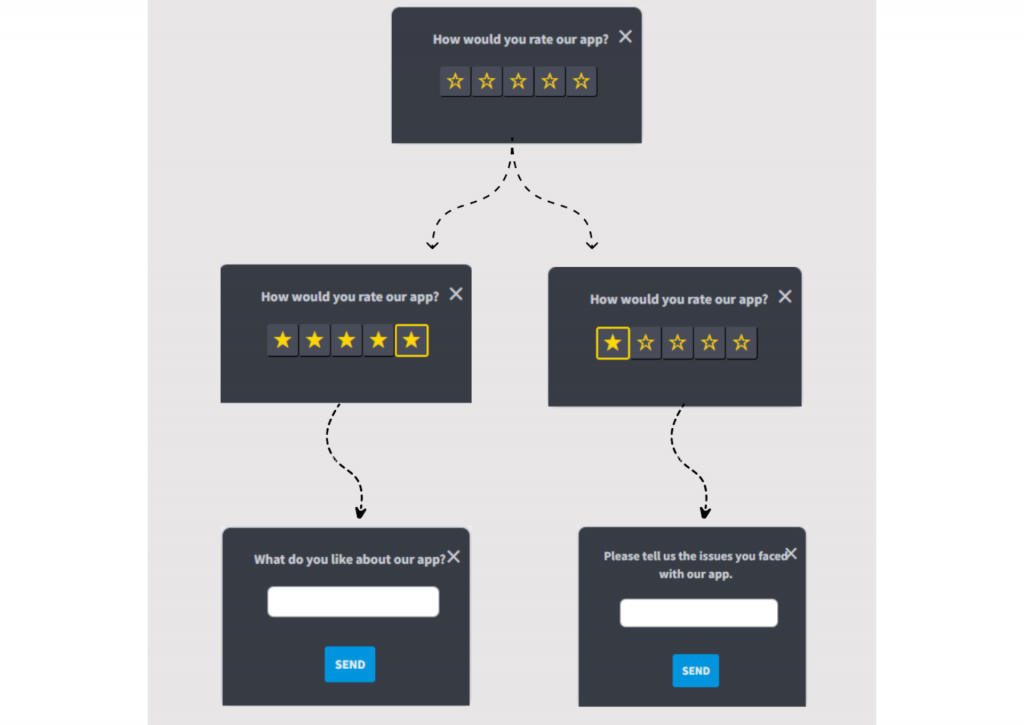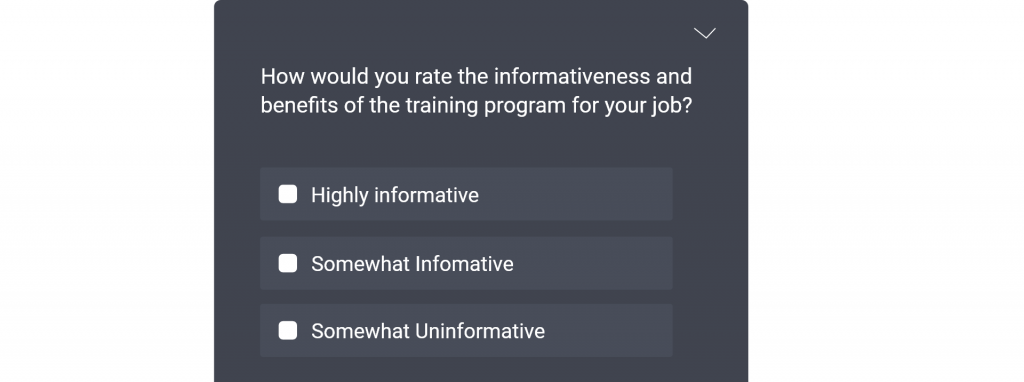When it comes to corporate training and development, 49% of companies in the US increased their budget in 2022 compared to 41% in 2021.
While this data is enough to convince anyone about the importance of employee training programs, the question of ‘How to conduct effective training’ remains.
One possible answer to this is the training surveys.
These surveys not only help you evaluate the effectiveness of your current training endeavors but also prepare you better for future development programs.
In this article, we’ll delve into the fundamentals of training surveys, their benefits, pre- and post-training survey question examples, and tips for creating effective training feedback surveys.
What Are Employee Training Surveys?
A training survey is a structured set of questions designed to collect feedback and insights from individuals who will or have recently participated in a training program or course.
These surveys serve a dual purpose: first, they help trainers and organizations understand the effectiveness of their training initiatives, and second, they provide valuable feedback to ensure continuous improvement.
Pre- and Post-Training Surveys Questions You Can Ask
Employee training surveys typically include a mix of pre-training and post-training questions. Let’s have a look at each one and their question examples.
1. Pre-Training Survey Questions
Before your training program begins, pre-training surveys are critical in understanding your participants’ expectations and needs. These feedback questions for training help you tailor your training content to meet those expectations.
Here are some sample pre-training survey questions you can use in your survey:
- What do you think you’ll get from this training?
- What level of expertise are you expecting from this training session?
- What motivated you to enroll in this training program?
- What specific skills or knowledge are you hoping to acquire through this training?
- Have you previously received training on a similar topic?
- How familiar are you with the training platform or technology that will be used during the program?
2. Post-Training Survey Questions
Post-training surveys, conducted after the training program, provide valuable feedback that can help you assess the effectiveness of your training. Below is a collection of post-training survey templates and questions you can use to measure the impact of your training:
Training Expectations and Learning Confidence:
- Did the training meet your expectations?
- How confident do you feel in applying the newly acquired knowledge or skills in your role?
- Were there any specific challenges or difficulties you encountered during the training?
- What additional topics or areas would you like to see covered in future training sessions?
Training Session Assessment:
- What did you like the most about the training session?
- How would you rate the overall quality of this training session?
- How would you rate the training materials and resources (e.g., handouts, online resources, etc.)?
- Do you believe an additional follow-up session is necessary for this training?
- Do you have any suggestions for improving the training content or delivery for future sessions?
- Did the training course effectively reflect the promises made in its title and description?
- How engaging and interactive did you find the training program?
- Was the pace of the training comfortable, or did it feel excessively fast or slow?
- Was the training venue comfortable for your learning experience?
- Did the training environment enhance your ability to learn? (e.g., noise level, temperature, etc.)
- How would you rate your satisfaction with this training session?
- Were you provided opportunities for effective collaboration with your peers during the training?
- Did you find the number of participants in the training session suitable?
- Did you have sufficient time and resources at your disposal to successfully complete the training?
- In your opinion, what would be the optimal training delivery method for this course in the future: instructor-led in-person training or online eLearning?
- Do you have any recommendations to enhance the learning experience or the training environment for upcoming workshops?
Instructor Evaluation:
- How would you rate the overall performance of the training instructor?
- Specifically, how would you assess the quality of instruction provided by the trainer?
- Did the instructor demonstrate comprehensive knowledge of the subject matter?
- Was the instructor approachable and friendly?
- Did the trainer effectively engage and provide support to the participants?
- Was the instructor’s communication clear and easy to understand? (e.g., clarity, volume, jargon usage)
- Did the instructor offer practical examples for applying the training material?
- Did the instructor incorporate interactive activities into the training?
- Was the training program well-structured and easy to follow?
Online Training Evaluation:
- Did you encounter any specific challenges while using the online training platform?
- Do you believe that online training was more effective compared to traditional, instructor-led training?
Bonus Read: Employee Satisfaction Surveys – A Complete Guide To Boost Turnover
How Can Training Surveys Help You?
Training surveys guide you toward a well-trained, engaged, and productive workforce. But their benefits go beyond this. Here are some reasons why businesses leverage training surveys, and you should too:
Evaluate and Improve Training Programs
Training surveys offer insights that help you continuously improve your training content and methods. They are your feedback mechanism to ensure your training and materials don’t have gaps and issues.
Also, employee growth and learning need to evolve. What was effective a year ago might not be as impactful today. It is where training surveys help you identify these changing needs, allowing you to shape training programs that are always in tune with your employees’ requirements.
Enhance Employee Engagement
It’s no secret that well-trained employees are more engaged, productive, and motivated. Pre-training surveys are a way to show employees that their opinions matter even before they start training. Post-training surveys help you improve and deliver more valuable training experiences.
By conducting these surveys, you’re telling your employees, “We care about your growth,” which, in turn, nurtures a culture of loyalty and commitment.
Direct Communication
Surveys establish a direct line of communication between your organization and your employees. This open channel can help promptly address training issues and concerns, preventing minor problems from turning into significant challenges.
Strategically Align Employees’ Needs With Their KPIs
Training should not be a standalone activity but sync with your organizational goals. You can use training surveys as a lens into this alignment. So, when planning your training program, ask this question to the employees— Is the training program contributing to your KPIs?
If the responses aren’t what you want, you can plan better training programs that align with employees’ needs, KPIs, and business objectives.
When to Run a Training Survey
The timing of your training survey is crucial. Ideally, you should conduct a pre-training survey a few hours before the training session and post-training surveys immediately after each training session or course, within 24 hours of completion. It ensures you gather feedback while the experience is fresh in participants’ minds.
Tips to Create Training Surveys With High Response Rates
If your training survey isn’t impeccable, your employees won’t engage, and you won’t get the insights you need. To avoid this situation, refer to these survey tips while creating and conducting training surveys.
1. Set Your Objectives
Before creating your survey, decide what you want to achieve. For example, are you looking for feedback on a particular training program? Or assessing broader training needs? Or do you want a glimpse into the current skill set of your workforce for development?
Having a clear objective will guide the survey’s design and purpose. You can ask feedback questions for training based on the type of employee data you want to collect.
2. Balance the Number of Questions
Asking too many feedback questions for training one after another can discourage and tire participants, while too few may not provide enough information.
So, what’s one to do?
Find the right balance to ensure participants are engaged but not overwhelmed. Create a list of questions and then gauge the kind of data they’ll get.
If the questions don’t bring the desired results, you can skip them. This way, you’ll only ask what needs to be asked and not what should be asked.
3. Keep the Questions Short by Asking One Thing at a Time
Long questions don’t do you any favors. If anything, they confuse respondents, skewing your feedback data. So, try asking one thing at a time and keep your questions concise and easy to understand. This way, the participants won’t abandon the survey.
For example:
The Wrong Way: “Do you think the instructor and the material provided in the training were effective?”
The Right Way: “Do you think the instructor was effective during the training session?”
4. Use Branching and Skip Logic for Relevancy
If you want precise data and insights, you need to ask the right questions to the right people. It is where you can leverage Qualaroo, an online survey maker tool. It comes with its branching and skip logic that can make all the difference in making your training surveys more personalized and relevant.
You can tailor the questions based on participants’ previous responses to keep the survey relevant and engaging while allowing them to skip irrelevant questions.
Here’s how branching logic works:

5. Put the Questions in a Logical Order
Organize your questions in a logical sequence to get the most accurate data. Start with simple, non-intrusive inquiries and progress to more specific or sensitive ones. This logical order ensures a smoother participant experience.
6. Avoid Asking Leading Questions
Try to avoid leading questions or vocabulary, which could influence participants’ responses. The goal is to gather honest and accurate feedback.
For example:
The Wrong Way: “Did you find the training program highly informative and beneficial for your job?”
The Right Way: “How would you rate the informativeness and benefits of the training program for your job?”

If you want to know more about conducting effective training surveys, check out this guide on survey errors you should be aware of and avoid.
Training Surveys: Refining Your Employee Development Programs
Employee training surveys serve as valuable tools for optimizing training programs. These feedback questions for training provide data to help refine your content, methods, and training strategy.
This continuous improvement approach fosters an engaged and open dialogue with employees, showcasing a commitment to their development.
So, if you want to retain your top talent, prioritize employee growth, and drive organizational success, start listening to what your employees think and use the feedback to create development programs employees want.
FREE. All Features. FOREVER!
Try our Forever FREE account with all premium features!

